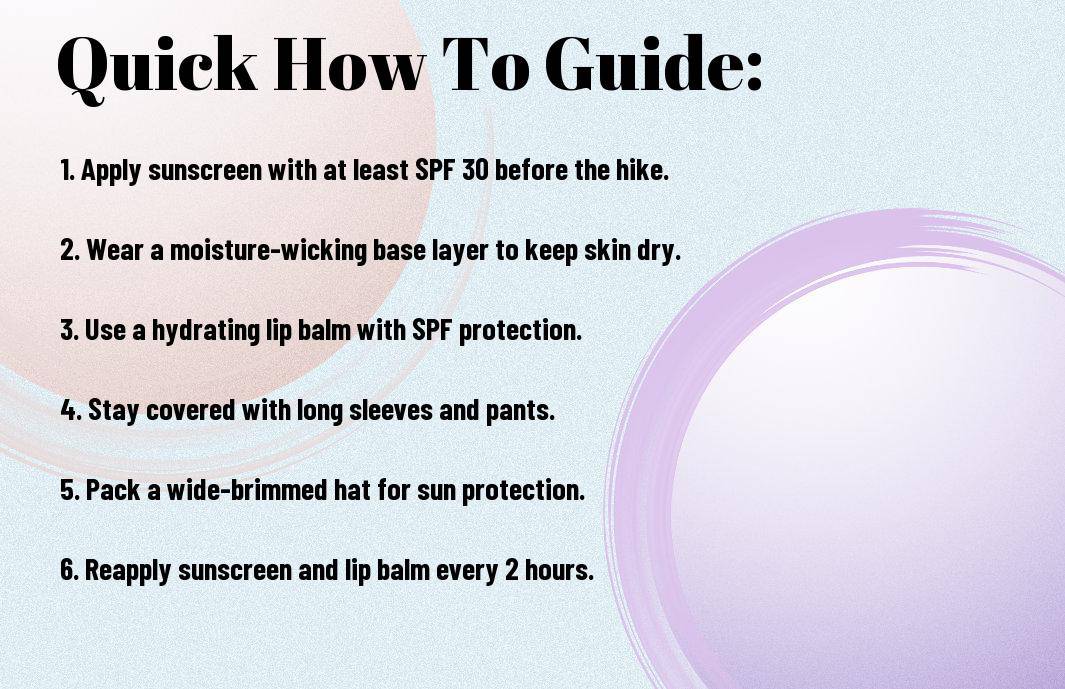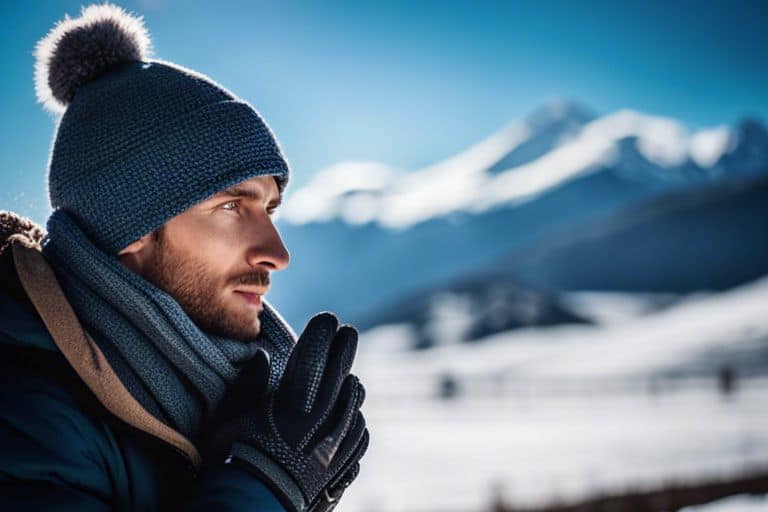Embarking on a winter hike can be a thrilling and invigorating experience, but the harsh elements present a potential risk to your skin. Protecting your skin from the cold, dry air and strong UV rays is crucial to enjoying a safe and comfortable outdoor adventure. In this guide, we will discuss essential tips and techniques to shield your skin from the damaging effects of winter weather while on a hike. By following these simple yet effective measures, you can ensure that your skin remains healthy and radiant even in the harshest winter conditions. Don’t let the cold deter you from enjoying the great outdoors – with the right protection, you can have a fulfilling and enjoyable winter hike.
Key Takeaways:
- Maintain Proper Hydration: Staying hydrated is essential for healthy skin, especially during winter. Drink plenty of water before and during your winter hike to prevent dry and chapped skin.
- Protective Clothing: Dress in layers and wear moisture-wicking fabrics to protect your skin from the harsh cold and wind. Don’t forget to wear a hat, gloves, and thermal socks to keep extremities covered.
- Apply Sunscreen: Even in the winter, UV rays can still damage your skin. Apply a broad-spectrum sunscreen with an SPF of 30 or higher to all exposed skin to prevent sunburn and premature aging.
- Moisturize Regularly: Use a rich, emollient moisturizer to keep your skin hydrated and protected from the drying effects of the cold, windy air. Don’t forget to reapply as needed throughout your hike.
- Protect Your Lips: Use a lip balm with SPF to prevent chapping and sun damage. Choose a moisturizing formula to keep your lips soft and smooth during your winter hike.

Before the Hike
Clearly, preparation is key when it comes to protecting your skin on a winter hike. Before you hit the trails, take the time to assess the weather conditions, prepare your skin care kit, and choose appropriate clothing.
Assessing the Weather Conditions
Before heading out, it’s crucial to check the weather forecast for the day of your hike. Extreme cold, wind, and low humidity can all have a significant impact on your skin. Pay attention to the temperature, wind speed, and any chance of precipitation. This will help you determine the level of protection your skin will need.
Preparing Your Skin Care Kit
Prior to your winter hike, ensure that you have all the necessary items in your skin care kit. This should include a moisturizing sunscreen with an SPF of at least 30, lip balm with SPF, a hydrating facial mist, and a rich moisturizer. Additionally, pack a small first aid kit in case of any unexpected skin injuries along the way.
Choosing Appropriate Clothing
When it comes to dressing for a winter hike, layers are your best friend. Make sure to wear moisture-wicking base layers to keep sweat away from your skin, followed by insulating layers to keep you warm, and a waterproof and windproof outer layer to protect you from the elements. Don’t forget to cover your extremities with warm gloves, a hat, and insulated, waterproof footwear.

During the Hike
For many outdoor enthusiasts, winter hiking is a cherished activity that provides breathtaking views and a sense of adventure. However, the cold, dry air and harsh winds can take a toll on your skin. Taking the proper precautions and being aware of the potential risks can help you enjoy your winter hike without the negative effects on your skin.
Tips for Managing Skin Exposure
When you’re out on a winter hike, it’s crucial to protect your skin from the elements. To minimize exposure, cover as much skin as possible with protective clothing. This includes wearing a hat, gloves, and a scarf or neck gaiter to shield your face. Additionally, applying a moisturizing sunscreen to any exposed skin can help create a barrier against the harsh winter sun and wind. Be sure to reapply sunscreen every few hours to maintain its effectiveness. Keeping your skin covered and moisturized will help prevent dryness, cracking, and windburn. Knowing the right clothing and skincare products can make all the difference in protecting your skin during your winter hike.
Recognizing the Signs of Frostbite and Windburn
During a winter hike, it’s important to keep an eye out for the signs of frostbite and windburn. Frostbite can cause skin to become cold, numb, and pale, often turning red or blue as it thaws. If you notice any of these symptoms, it’s crucial to seek shelter and warm up the affected area immediately. Windburn can cause skin to become red, dry, and irritated, often feeling hot and tight to the touch. Applying a soothing moisturizer and taking measures to protect your skin from further exposure can help alleviate these symptoms. Recognizing these signs early on can prevent more serious damage to your skin.
Hydration and Nutrition for Skin Health
Staying hydrated and nourished is critical for maintaining healthy skin during a winter hike. The cold, dry air can deplete your body’s moisture levels, leading to dry and irritable skin. Make sure to drink plenty of waterto keep your skin hydrated from the inside out. Additionally, consuming foods rich in healthy fats and antioxidants can help protect your skin from the effects of cold weather. Including items like nuts, avocados, and berries in your trail mix can provide your skin with the nutrients it needs to stay resilient. By prioritizing hydration and nutrition, you can ensure that your skin remains healthy and strong throughout your winter adventure.
Specific Protection Strategies
After ensuring you have the right clothing for your winter hike, it’s time to focus on specific protection strategies to keep your skin safe. Here are some essential tips to help safeguard your skin from the harsh winter elements.
Protecting Exposed Skin
When hiking in the winter, it’s crucial to protect any exposed skin from the cold, wind, and potential sun exposure. Make sure to apply a moisturizing sunscreen to any exposed areas, including your face, neck, and hands. The combination of cold temperatures and sunlight can still result in UV radiation damage, so don’t underestimate the need for sunscreen, even in the winter. Additionally, consider using a protective lip balm to prevent chapping and cracking caused by the wind.
Safeguarding Against UV Radiation
Even in the winter, UV radiation from the sun can pose a threat to your skin. The snow can act as a reflective surface, intensifying the sun’s rays and increasing your risk of sunburn. To protect your skin, apply a broad-spectrum sunscreen with a high SPF before heading out on your hike. Reapply it every two hours, especially if you’re sweating or in snowy conditions, to ensure continuous protection against harmful UV rays. Don’t forget to shield your eyes with sunglasses that offer UV protection to prevent damage to the delicate skin around your eyes.
Combating the Cold
The cold temperatures during a winter hike can take a toll on your skin, leading to dryness, irritation, and even frostbite if not properly addressed. To combat the cold, make sure to layer your clothing to trap heat and protect your skin from the elements. Apply a rich moisturizer to your skin before heading out to form a protective barrier against the cold, and don’t forget to bring along an extra pair of gloves or mittens to swap out if your hands get damp or cold.
Post-Hike Skin Care
Unlike summer hikes, winter hikes can be much harsher on your skin due to the cold, wind, and dry air. After your winter hike, it’s important to take care of your skin to prevent any damage and ensure it stays healthy. Post-hike skin care is just as important as pre-hike skin protection. Here’s what you need to know to take care of your skin after a winter hike:
Cleaning and Repairing Your Skin
After a winter hike, it’s crucial to clean and repair your skin to prevent any potential damage. Start by gently cleansing your skin to remove any dirt, sweat, and bacteria that may have accumulated during your hike. Use a mild cleanser that won’t strip your skin of its natural oils. Then, apply a rich moisturizer to help repair and nourish your skin. Look for a moisturizer that contains ingredients like hyaluronic acid, glycerin, or ceramides to help hydrate and repair your skin’s barrier.
Additionally, if you have any cuts or scrapes from your hike, make sure to clean them thoroughly with antiseptic and apply a bandage. This will help prevent infection and promote faster healing of the skin. Taking these steps will ensure that your skin stays healthy and intact after a challenging winter hike.
Assessing for Cold-Related Skin Damage
After your winter hike, it’s important to assess your skin for any cold-related damage. Check for signs of frostbite, such as red or pale skin, numbness, or a prickling sensation. If you notice any of these symptoms, it’s crucial to warm up the affected area slowly and seek medical attention if necessary. Additionally, be on the lookout for chapped or cracked skin, which can occur due to exposure to the harsh winter elements. Apply a thick, emollient cream to these areas to help soothe and repair the skin.
Long-Term Skin Care Considerations
As you continue to enjoy winter hikes, it’s important to consider the long-term care of your skin. Protecting your skin from the sun is just as important in winter as it is in summer, as snow can reflect harmful UV rays. Make sure to apply a broad-spectrum sunscreen to any exposed skin before heading out on your hike. Additionally, incorporate a regular exfoliation routine into your skincare regimen to remove dead skin cells and prevent dryness. Finally, consider adding a humidifier to your home to combat the dry air that can contribute to parched skin during the winter months.
Special Considerations
Your winter hike may require some special considerations to protect your skin in certain situations. Here are a few additional factors you should take into account to ensure your skin stays healthy and protected.
Skin Protection for Children on Winter Hikes
When taking children on a winter hike, it’s crucial to pay extra attention to their skin protection. Children have thinner and more sensitive skin than adults, making them more susceptible to harsh winter conditions. Make sure they are dressed in appropriate layers and use gentle, hydrating sunscreen to shield their delicate skin from the sun’s rays, even on overcast days. Additionally, remember to reapply sunscreen throughout the hike, especially if they are sweating or playing in the snow.
Adapting Skin Care for High Altitudes
If you plan on hiking in high altitudes during the winter, be aware that the UV radiation increases by about 4% for every 1,000 feet of elevation. As a result, it’s crucial to use a broad-spectrum sunscreen with a high SPF to protect your skin from the intensified sun exposure. Also, consider using a moisturizing lip balm with SPF to prevent chapping and sun damage to your lips. Moreover, the higher elevation can lead to drier air, which can further dehydrate your skin, so be sure to pack a rich, emollient moisturizer to keep your skin hydrated and supple.
Dealing with Pre-Existing Skin Conditions
If you have pre-existing skin conditions such as eczema or psoriasis, winter hikes can exacerbate your symptoms. The cold, dry air can strip your skin of its natural oils, leading to increased irritation and flare-ups. It’s essential to moisturize regularly with a gentle, fragrance-free moisturizer and avoid hot showers or baths, which can further dry out your skin. Additionally, consider wearing protective clothing made from soft, breathable fabrics to minimize friction and irritation on sensitive areas.
Common Mistakes to Avoid
Keep these common mistakes in mind to ensure you protect your skin while on a winter hike.
Ignoring Weather Alerts and Warnings
One of the most dangerous mistakes you can make is ignoring weather alerts and warnings. It’s important to check the forecast and heed any advisories before heading out on your hike. Ignoring this information puts you at risk for exposure to extreme conditions, which can lead to frostbite or hypothermia. Always stay informed and be prepared with the right gear for the conditions you may encounter.
Underestimating the Sun’s Power in Winter
Don’t make the mistake of underestimating the sun’s power in winter. Even though the temperatures are cooler, the sun’s UV rays can still be dangerous to your skin. Reflective surfaces like snow can amplify UV exposure, increasing your risk of sunburn. Remember to apply sunscreen to any exposed skin, including your face, neck, and hands. Additionally, consider wearing sunglasses to protect your eyes from UV damage.
Forgetting to Adjust Skincare to Activity Level
When hiking in winter, adjusting your skincare routine to your activity level is crucial. If you’re exerting yourself and sweating, it’s important to reapply sunscreen and moisturizer as needed. Failure to do so can result in dry, chapped skin and increased sun damage. On the other hand, if you’re in a cold and windy environment, your skin may require additional protection and hydration. Be mindful of your activity level and make adjustments to your skincare routine accordingly to keep your skin healthy and protected.
Summing up: How to Protect Your Skin on a Winter Hike
As you venture into the winter wilderness, it’s essential to prioritize the protection of your skin. Remember to dress in layers to avoid exposure to the cold and wind, and to use a high-quality sunscreen to shield your skin from UV rays, even on overcast days. Don’t forget to keep your skin well-hydrated by drinking plenty of water and using moisturizer to combat the dry air. Planning for a winter hike with these skin protection strategies will help ensure that you can enjoy the beauty of the season while keeping your skin healthy and safe.
FAQ: Protect Your Skin on a Winter Hike
Q: Why is it important to protect your skin during a winter hike?
A: During winter, the cold, dry air can cause skin to become easily dehydrated, leading to chapping, redness, and discomfort. Additionally, the sun’s rays can still be damaging even in cold weather, so it’s essential to protect your skin from UV exposure.
Q: What are the essential items for protecting skin on a winter hike?
A: The essential items for protecting your skin on a winter hike include sunscreen, lip balm with SPF, moisturizer, and protective clothing such as hats, scarves, and gloves. Additionally, it’s important to stay hydrated by drinking plenty of water.
Q: How often should sunscreen be applied during a winter hike?
A: Sunscreen should be applied at least every two hours, or more frequently if you are sweating or coming into contact with water. Even on overcast days, UV rays can still penetrate through clouds, so it’s crucial to reapply sunscreen regularly.
Q: What type of moisturizer is best for protecting skin during a winter hike?
A: Look for a moisturizer that is thick and emollient, as this will provide a barrier to protect your skin from cold, windy conditions. Ingredients like shea butter, cocoa butter, and hyaluronic acid can help to keep your skin hydrated and protected.
Q: What clothing should be worn to protect skin during a winter hike?
A: Wear layers of clothing to protect your skin during a winter hike, including a moisture-wicking base layer, an insulating layer, and a waterproof and windproof outer layer. Hats, scarves, and gloves should also be worn to protect vulnerable areas from the elements.



0 Comments